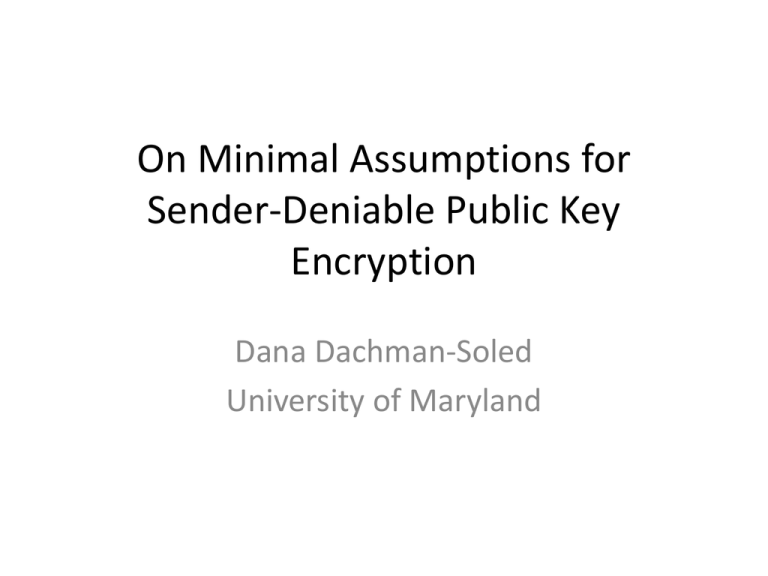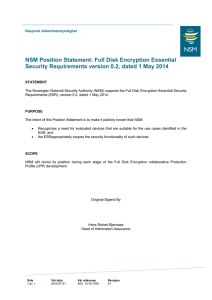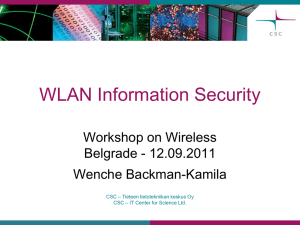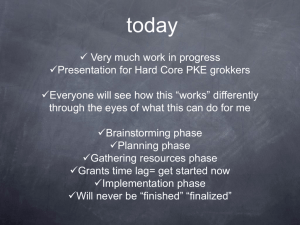slides
advertisement

On Minimal Assumptions for Sender-Deniable Public Key Encryption Dana Dachman-Soled University of Maryland Deniable Public Key Encryption [Canetti, Dwork, Naor, Ostrovsky, 97] 𝑝𝑘 𝑐 = 𝐸𝑛𝑐𝑝𝑘 (𝑚; 𝑟) Sender Receiver s𝑘 Outputs: 𝐷𝑒𝑐𝑠𝑘 𝑐 = 𝑚 For any 𝑚′ in the message space, can produce a fake opening (𝑟′, 𝑠𝑘′) explaining the transcript as an encryption of 𝑚′ . Sender-Deniable Public Key Encryption [Canetti, Dwork, Naor, Ostrovsky, 97] 𝑝𝑘 𝑐 = 𝐸𝑛𝑐𝑝𝑘 (𝑚; 𝑟) Sender Receiver s𝑘 Outputs: 𝐷𝑒𝑐𝑠𝑘 𝑐 = 𝑚 Applications: definition Receiver-Deniable Key For Analogous any 𝑚′ in the messageforspace, can produce aPublic fake opening • After the fact incoercibility Encryption 𝑟′ explaining the transcript as an encryption of 𝑚′ . • Adaptive security What is known? • Receiver-Deniable PKE and thus Deniable PKE is impossible [Bendlin, Nielsen, Nordholt, Orlandi, 11]. • Sender-Deniable encryption with weak security from standard assumptions [Canetti, Dwork, Naor, Ostrovsky, 97]. • Bi-Deniable encryption in the multi-distributional model constructed by [O’Neill, Peikert, Waters, 11] • [Sahai, Waters 14] achieve Sender-Deniable public key encryption from indistinguishability obfuscation (IO). – Non-black box use of underlying primitives. – Requires strong assumptions (FHE + multilinear maps). Our Goal • Understand minimal assumptions necessary for sender-deniable public key encryption. • Necessity of non-black-box techniques. Is there a black-box construction of senderdeniable public key encryption from simulatable public key encryption? Underlying primitive we consider Simulatable Public Key Encryption Algorithms (𝑜𝐺𝑒𝑛, 𝑟𝐺𝑒𝑛), (𝑜𝐸𝑛𝑐, 𝑟𝐸𝑛𝑐) (𝑟𝐺 , pk) s.t. 𝑜𝐺𝑒𝑛 𝑟𝐺 = 𝑝𝑘 “Oblivious” (𝑝𝑘, 𝑟𝐸 , 𝑐) s.t. 𝑜𝐸𝑛𝑐 𝑝𝑘, 𝑟𝐸 = 𝑐 ≈ (𝑟 ′ 𝐺 , pk) s.t. 𝐺𝑒𝑛 𝑟𝐺 = 𝑝𝑘 𝑟 ′ 𝐺 = 𝑟𝐺𝑒𝑛 𝑝𝑘 (𝑝𝑘, 𝑟 ′ 𝐸 , 𝑐) s.t. 𝐸𝑛𝑐 𝑝𝑘, 𝑟𝐸 = 𝑐 𝑟 ′ 𝐸 = 𝑟𝐸𝑛𝑐 𝑝𝑘, 𝑐 Why this primitive? Simulatable PKE is sufficient for related primitives: Intuition: • Bi-deniable Can generate encryption a public in the key/ciphertext multi-distributional honestly model and claim [OPW11] that it • 1/poly-secure was sender-deniable generated obliviously. encryption [CDNO97] • Non-committing encryption [CFGN96]. Weak Sender-Deniable PKEfrom Simulatable PKE Simplification of [CDNO97] construction: 𝐸𝑝𝑘 (0𝑘 ) Obliv. Obliv Obliv 𝐸𝑝𝑘 (0𝑘 ) Obliv. ... 𝐸𝑝𝑘 (0𝑘 ) Obliv Obliv k ciphertexts ToToencrypt a 0, setsay odd number of ciphertexts to oblivious. deny, lie and that an honestly generated ciphertext was generated To encrypt a 1, set an even number of ciphertexts to oblivious. obliviously. Polynomial security: Real and Fake openings can be distinguished with 1/poly Problem: Cannot lie and claim that an obliviously generated ciphertext was advantage generated non-obliviously. Super-polynomial security: Real and Fake openings can only be distinguished with Only achieves O(k) security, where k is the number of queries made by encryption. negligible advantage Our Results Theorem: There is no black-box construction of sender-deniable public key encryption with super-polynomial security from simulatable public key encryption. More specifically: Every black-box construction of a senderdeniable PKE scheme from simulatable PKE which makes 𝑚 queries to the simulatable PKE cannot achieve security better than O(𝑚4 ). Nearly tight with [CDNO97] construction. Some Proof Intuition Oracle separation: Oracle relative to which Simulatable PKE exists, Sender-Deniable PKE does not exist. Our oracle: Important: random string is unlikely to be in the range • 𝐺: 0,1 𝑛 → 0,1 3𝑛 takes inputs 𝑠𝑘 and outputs 𝑝𝑘.of 𝐺 or 𝐹 𝑝𝑘,∗ . • 𝐹: 0,1 4𝑛 → 0,1 12𝑛 takes inputs (𝑝𝑘, 𝑥) and outputs 𝑦. • 𝐹 −1 : 0,1 13𝑛 → 0,1 𝑛 takes inputs (𝑠𝑘, 𝑦 )and returns 𝑥 if 𝐺(𝑠𝑘) = 𝑝𝑘 and 𝐹(𝑝𝑘, 𝑥) = 𝑦 and ⊥ otherwise. Simulatable PKE relative to oracle: • First 𝑘 bits of input x is plaintext. • Public keys and ciphertexts are indistinguishable from random strings: 𝑜𝐺𝑒𝑛(𝑟𝐺 ), 𝑜𝐸𝑛𝑐(𝑟𝐸 ) output 𝑟𝐺 , 𝑟𝐸 . 𝑟𝐺𝑒𝑛(𝑝𝑘), 𝑟𝐸𝑛𝑐(𝑝𝑘, 𝑐) output 𝑝𝑘 and 𝑐 itself. Some Proof Intuition Impossibility of Sender-Deniable Encryption: In a super-polynomially-secure scheme, should be able to run deny an unbounded polynomial 𝑝 number of times and have that: • 𝑟0 , 𝑐 = 𝐸𝑛𝑐𝑝𝑘 𝑏; 𝑟0 original randomness • 𝑟1 = 𝐷𝑒𝑛𝑦𝑝𝑘 𝑟0 , 1 − 𝑏 , 𝑐 looks fresh • (𝑟2 = 𝐷𝑒𝑛𝑦𝑝𝑘 𝑟1 , 𝑏 , 𝑐) looks fresh ... • (𝑟𝑝 = 𝐷𝑒𝑛𝑦𝑝𝑘 𝑟𝑝−1 , 1 − 𝑏 , 𝑐) looks fresh In the oracle case: We consider sequences of Sender views 𝑉𝑖𝑒𝑤𝑆0 , 𝑉𝑖𝑒𝑤𝑆1 , … , 𝑉𝑖𝑒𝑤𝑆𝑝 . Each view contains the input bit, random tape, oracle queries + responses. Some Proof Intuition • Correctness of encryption guarantees: – If Sender’s view is an encryption of a bit b, then Receiver’s view sampled conditioned on Sender’s view will be a decryption of the same bit b w.h.p. 𝑉𝑖𝑒𝑤𝑅 | 𝑉𝑖𝑒𝑤𝑆 – Using [Impagliazzo, Rudich, 89]-type techniques: 𝑄 is the set of likely intersection • 𝑆 can use Eve algorithm to findqueries set 𝑄 of likely intersection between 𝑆, 𝑅 given 𝑆’squeries view. between 𝑆 and 𝑅: 𝑉𝑖𝑒𝑤𝑅 𝑉𝑖𝑒𝑤𝑆 , 𝑄 ≈ 𝑉𝑖𝑒𝑤𝑅 𝑝𝑘, 𝑐, 𝑄 – Note that (𝑝𝑘, 𝑐) are fixed. – The only way to change the distribution of 𝑉𝑖𝑒𝑤𝑅 | 𝑉𝑖𝑒𝑤𝑆 , 𝑄 is to change the set 𝑄. – Distribution must change in each iteration. A First Attempt Consider the set 𝑄0 generated by 𝑆 from its real 𝑉𝑖𝑒𝑤𝑆0 . Let 𝑄𝑖 be the set corresponding to fake 𝑉𝑖𝑒𝑤𝑆𝑖 . “Claim”: Q 𝑖 ⊆ 𝑄0 Therefore, in order to change distribution over Receiver’s view, queries must be removed each time. • There are at most poly number of queries in real 𝑄0 so deny can be run at most a polynomial number of times before it fails. So cannot get super-polynomial security. • “Claim”: Intuitively, this is what happens in [CDNO97] construction. • • • • Problem • “Claim” is false! It is possible that 𝑄𝑖 ∖ 𝑄0 ≠ ∅. • Toy Example: 12n encryptions To encrypt a 0: 𝐸(𝑝𝑘, 0𝑘 ) 𝐸(𝑝𝑘, 0𝑘 ) 𝐸(𝑝𝑘, 0𝑘 ) 𝐸(𝑝𝑘, 0𝑘 ) Obliv 𝐸(𝑝𝑘, 0𝑘 ) To encrypt a 1: Compute 𝑐 ∗ = 𝐹(𝑝𝑘, 𝑟 ∗ ); Say 𝑐 ∗ = 01. . .10, length 12𝑛 bits. 𝐸(𝑝𝑘, 0𝑘 ) Obliv 𝑘 ; 𝑟 . 0. Decrypt: Note:Decrypt In 0 case, 12n intersection ciphertexts.queries If theywill all consist output of 0𝑘 0 , output 𝑖 ∗ ∗ ∗ Otherwise, In 1 case, compute intersection 𝑐 and queries decrypt will to get contain 𝑟 . Output 𝑟 . 1. Problem • “Claim” is false! It is possible 𝑄𝑖 ∖ 𝑄0 ≠ ∅. • Toy Example: Can claim an encryption of 0 is an encryption of 1: In the process will add an arbitrary query to set of intersection queries. 𝐸(𝑝𝑘, 0𝑘 ) 𝐸(𝑝𝑘, 0𝑘 ) 𝐸(𝑝𝑘, 0𝑘 ) 𝐸(𝑝𝑘, 0𝑘 ) Obliv 𝐸(𝑝𝑘, 0𝑘 ) Compute 𝑐 ∗ = 𝐹(𝑝𝑘, 𝑟 ∗ ); Say 𝑐 ∗ = 01. . .10 𝐸(𝑝𝑘, 0𝑘 ) Obliv Note: Intersection queries now include, 𝑟 ∗ . Some Proof Intuition • Main technical part of proof is to deal with the case that 𝑄𝑖 ∖ 𝑄0 ≠ ∅. • Use an information compression argument to show that w.h.p. over choice of oracle, we cannot have a sequence of openings with too many new queries. Some Proof Intuition • Since Eve makes a polynomial number of queries: Can encode a sequence of openings with a short string. So total possible number of encodings is small. – Intuition: To encode a query 𝑞 ∈ 𝑄𝑖 , use its index in the Eve algorithm. • For a fixed encoding, probability randomly chosen oracle is consistent with the encoded sequence of openings is small. – Follows from property of oracle that a random string is unlikely to be in image of 𝐹(𝑝𝑘,∗). • Since number of encodings is small, prob. a randomly chosen oracle is consistent with any sequence is small. Open Problems • Extend impossibility result to trapdoor permutations. • Extend impossibility results to multiple round encryption schemes. • Construct sender-deniable public key encryption without relying on IO? Thank you!






